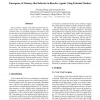Free Online Productivity Tools
i2Speak
i2Symbol
i2OCR
iTex2Img
iWeb2Print
iWeb2Shot
i2Type
iPdf2Split
iPdf2Merge
i2Bopomofo
i2Arabic
i2Style
i2Image
i2PDF
iLatex2Rtf
Sci2ools
ICTAI
2009
IEEE
2009
IEEE
Emergence of Memory-like Behavior in Reactive Agents Using External Markers
Early primitive animals with simple feed-forward neuronal circuits were limited to reactive behavior. Through evolution, they were gradually equipped with memory and became able to utilize information from the past. Such memory is usually implemented with recurrent connections and certain behavioral changes are thought to precede the reconstitution of the neuronal circuit’s topology. If so, what could have been the behavior to drive such a rewiring? Our hypothesis is that the secretion and detection of chemical markers in the environment could be a precursor of internal memory. We will show how memory-like behavior can be expressed in memoryless reactive agents by taking advantage of the external chemical markers. Our results show that given chemical marker use, reactive agents are able to develop intelligent strategies in solving a biologicaly plausible food foraging task requiring spatial memory. We also found interesting analogy between the evaporation of the chemical markers and...
| Added | 24 May 2010 |
| Updated | 24 May 2010 |
| Type | Conference |
| Year | 2009 |
| Where | ICTAI |
| Authors | Ji Ryang Chung, Yoonsuck Choe |
Comments (0)

